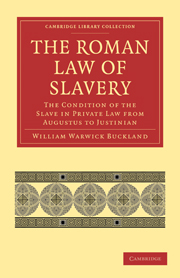Book contents
- Frontmatter
- PREFACE
- Contents
- ERRATA, ADDENDA, AND LIST OF ABBREVIATIONS
- LIST OF PRINCIPAL ABBREVIATIONS
- PART I CONDITION OF THE SLAVE
- PART II ENSLAVEMENT AND RELEASE FROM SLAVERY
- APPENDIX I The relation of the contractual actions adiectitiae qualitatis to the Theory of Representation
- APPENDIX II Formulation and Litis Consumptio in the actions adiectitiae qualitatis
- APPENDIX III Form used by Slave in acquisition by Mancipatio, etc.
- APPENDIX IV The essential character of Manumission: Iteratio
- APPENDIX V Manumission vindicta by a, filiusfamilias
- INDEX
APPENDIX V - Manumission vindicta by a, filiusfamilias
Published online by Cambridge University Press: 07 September 2010
- Frontmatter
- PREFACE
- Contents
- ERRATA, ADDENDA, AND LIST OF ABBREVIATIONS
- LIST OF PRINCIPAL ABBREVIATIONS
- PART I CONDITION OF THE SLAVE
- PART II ENSLAVEMENT AND RELEASE FROM SLAVERY
- APPENDIX I The relation of the contractual actions adiectitiae qualitatis to the Theory of Representation
- APPENDIX II Formulation and Litis Consumptio in the actions adiectitiae qualitatis
- APPENDIX III Form used by Slave in acquisition by Mancipatio, etc.
- APPENDIX IV The essential character of Manumission: Iteratio
- APPENDIX V Manumission vindicta by a, filiusfamilias
- INDEX
Summary
It is clear that manumission vindicta was a legis actio. It is also most probable that a filiusfamilias was incapable of legis actio. It appears to follow that he could not free vindicta, even iussu patris. Yet this power is repeatedly credited to him, and is nowhere expressly denied. On the texts as they stand there is therefore something like an absolute contradiction.
There seem to be two ways of dealing with the matter, assuming the truth of the proposition that a filiusfamilias cannot lege agere. One of these is that of Mitteis, to refer all the texts which do not specify the form to the informal methods and to treat the others as in some way interpolated. The other course is to accept the texts and to treat their rule as one more case in which the character of the process was disregarded. The following pages state as briefly as possible the grounds on which the present writer has held, and holds, this the better view.
The relaxations stated on p. 452 are no doubt for the most part merely evidences that the process was not really regarded as judicial. Some can hardly be so disposed of, but they are much less important than the texts directly touching the question, of which the chief are set out and discussed in the following pages.
- Type
- Chapter
- Information
- The Roman Law of SlaveryThe Condition of the Slave in Private Law from Augustus to Justinian, pp. 718 - 724Publisher: Cambridge University PressPrint publication year: 2010First published in: 1908



